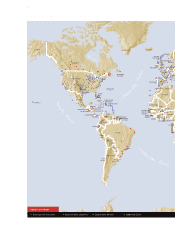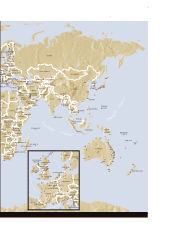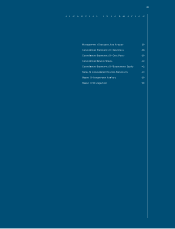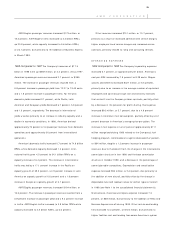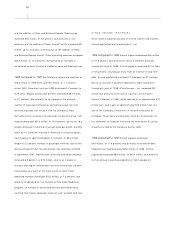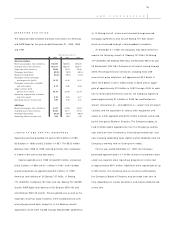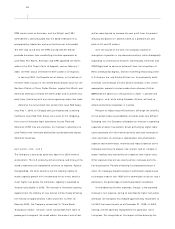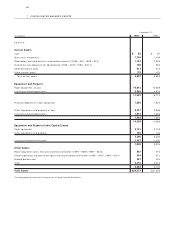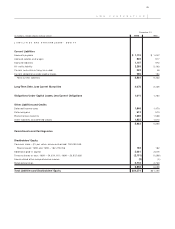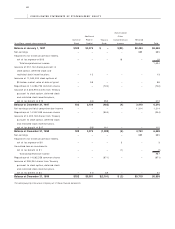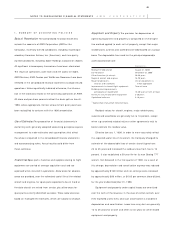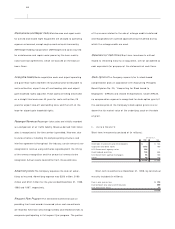American Airlines 1999 Annual Report Download - page 36
Download and view the complete annual report
Please find page 36 of the 1999 American Airlines annual report below. You can navigate through the pages in the report by either clicking on the pages listed below, or by using the keyword search tool below to find specific information within the annual report.
AMR CORPORATION
35
duration of the higher prices, which, at a minimum, will dampen
the Company’s first half 2000 financial results. In addition to the
direct effect, the higher fuel prices may, if sustained at their
current levels for an extended period of time, indirectly negatively
impact the Company by slowing the economy and thereby the
demand for air travel.
FORWARD-LOOKI NG INFORMATION
The preceding Letter from the Chairman, A Legacy of Leadership,
APromise to Our Customers, A Promise to Our People and A
Promise to Our Shareholders essays, and M anagement’s
Discussion and Analysis contain various forward-looking state-
ments within the meaning of Section 27A of the Securities Act of
1933, as amended, and Section 21E of the Securities Exchange
Act of 1934, as amended, which represent the Company’s
expectations or beliefs concerning future events. When used in
this document and in documents incorporated herein by
reference, the words “ expects,” “ plans,” “ anticipates,” and
similar expressions are intended to identify forward-looking
statements. Forward-looking statements include, without
limitation, expectations as to results of operations and financial
condition, including changes in capacity, revenues and costs,
expectations as to future financing needs, Year 2000 expectations,
overall economic projections and the Company’s plans and
objectives for future operations, including plans to develop future
code-sharing programs and to evaluate new alliances. All
forward-looking statements in this report are based upon
information available to the Company on the date of this report.
The Company undertakes no obligation to publicly update or
revise any forward-looking statement, whether as a result of new
information, future events or otherwise. Forward-looking
statements are subject to a number of factors that could cause
actual results to differ materially from our expectations. The
following factors, in addition to other possible factors not listed,
could cause the Company’s actual results to differ materially from
those expressed in forward-looking statements: uncertainty of
future collective bargaining agreements and events; economic
and other conditions; commodity prices; competition in the airline
industry; changing business strategy; government regulation; and
uncertainty in international operations. Additional information
concerning these and other factors is contained in the Company’s
Securities and Exchange Commission filings, including but not
limited to Form 10-K for 1999, copies of which are available from
the Company without charge.
MARKET RISK SENSITI VE INSTRUMENTS
AND POSI TIONS
The risk inherent in the Company’s market risk sensitive instruments
and positions is the potential loss arising from adverse changes in
the price of fuel, foreign currency exchange rates and interest
rates as discussed below. The sensitivity analyses presented do
not consider the effects that such adverse changes may have on
overall economic activity, nor do they consider additional actions
management may take to mitigate its exposure to such changes.
Actual results may differ. See Note 6 to the consolidated financial
statements for accounting policies and additional information.
Aircraft Fuel The Company’s earnings are affected by changes
in the price and availability of aircraft fuel. In order to provide
a measure of control over price and supply, the Company trades
and ships fuel and maintains fuel storage facilities to support
its flight operations. The Company also manages the price risk of
fuel costs primarily utilizing swap and option contracts. Market
risk is estimated as a hypothetical 10 percent increase in the
December 31, 1999 and 1998 cost per gallon of fuel. Based on
projected 2000 fuel usage, such an increase would result in
an increase to aircraft fuel expense of approximately $125 million
in 2000, net of fuel hedge instruments outstanding at


